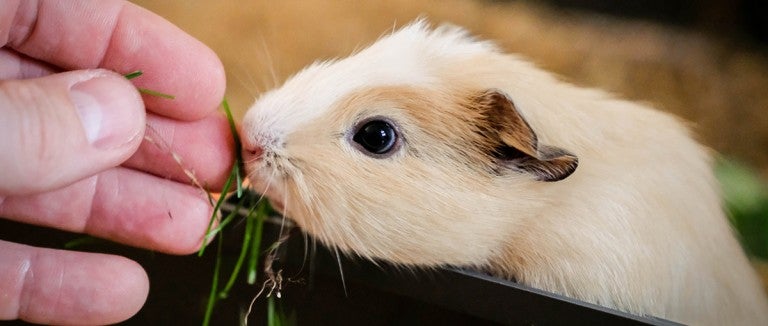Most cages marketed for guinea pigs are way too small. Guinea pigs need appropriate room to roam, with separate spaces for a nest, bathroom area and food and water. No animal is meant to live in a cage all the time, so make sure to provide your pig with time outside their enclosures at least once a day to stretch their legs, explore and exercise.
Bigger is better
Guinea pigs are one of the largest rodents kept as pets and yet their typical cage is only marginally roomier than housing for much smaller relatives like hamsters and gerbils.
While small animal cages often utilize vertical space to increase living area and encourage climbing, digging and burrowing, guinea pigs do not jump or climb and rely solely on floor space. Ramps and platforms at low heights provide variety, but guinea pigs need room to exercise, even with daily playtime outside of the cage.
The following recommendations are meant to serve as guidelines to help you determine how much space you need for your guinea pig(s). Your local humane society or guinea pig rescue organization may have minimal caging requirements that differ from those listed here.
The sides of your guinea pig enclosure must be at least 12” high and the top may be open, so long as other household pets do not have access to it. Many guinea pig rescue organizations recommend “C&C” cages, which are enclosures made from cubes and coroplast, a corrugated plastic. Plastic tubs, glass aquariums and cages with wire floors are NOT acceptable as guinea pig housing. The enclosure must have good ventilation, be easy to clean and disinfect, and have a floor that is gentle on a guinea pig’s delicate feet.
- One guinea pig: 7.5 square feet, or about 30”x 36”, is the bare minimum recommended, but bigger is better. (Keep in mind that guinea pigs are highly social, so it is best to have at least two guinea pigs who get along with each other.)
- Two guinea pigs: 7.5 square feet (minimum), but at least 10.5 square feet (30” x 50”) is preferred.
- Three guinea pigs: 10.5 square feet (minimum), but at least 13 square feet (30” x 62”) is preferred.
- Four guinea pigs: 13 square feet (minimum), but at least 30” x 76” is preferred.
Sign up to receive our exclusive e-book full of important information about caring for your pet, including training techniques and answers to frequently asked questions.

Benefits to your guinea pig
Roomier cages offer many advantages that will be enjoyed by both you and your pig:
- Larger enclosures are one of the most basic types of enrichment you can provide. Guinea pigs can live five to seven years and can become bored and depressed without adequate stimulation. Imagine spending your whole life in a walk-in closet; even with occasional breaks, life would be pretty dreary.
- Adequate room to exercise means that your guinea pigs are less likely to develop medical conditions such as heart disease, diabetes, bumblefoot and anal impaction—saving your guinea pigs pain and suffering, and minimizing your veterinary bills.
- With a roomier enclosure, guinea pigs can exercise on their schedule, not yours. Guinea pigs tend to be most active in the morning and evening when it may not be convenient to take them out for playtime.
- Larger digs increase the likelihood of peaceful co-existence among multiple guinea pigs (and since guinea pigs are social animals, they do best when housed together).
- Larger spaces are actually easier to clean because they prevent the build-up of waste and allow guinea pigs to separate their bathroom area from other activities.
- With the opportunity to express a wider range of natural behaviors, your guinea pigs will be happier and it will be easier to get to know their personalities.
Search Guinea Pig Cage Types on GuineaDad
Bedding
For bedding, cedar and pine shavings are NOT recommended due to chemicals they both contain. Especially when soiled, these aromatic wood shavings can produce fumes that irritate a guinea pig’s respiratory system and feet. Use bedding made from paper. Provide two to three inches of bedding so absorption is maximized.
Location is key
Once you've selected the right housing for your guinea pigs, you’ll need to determine where in your home they will live. Here are some factors to consider:
Temperature
The ideal temperature range for guinea pigs is approximately 65-75 degrees Fahrenheit. Guinea pig housing should be located away from strong heat sources such as direct sun, wood stoves, fireplaces and heating vents. Guinea pigs cannot sweat when they become too warm and are particularly susceptible to heat stroke.
Don't put your guinea pig’s cage in an unheated room, breezeway, garage or other chilly location. Place the cages in a draft-free area (i.e. away from doors and windows and on an elevated surface).
Guinea pigs don’t do well under humid conditions. Dampness promotes the growth of mold in their hay and bedding and can make guinea pigs more prone to sickness.
Activity level
Guinea pigs enjoy being near family activity and benefit from more attention when they’re easy to see and hear. A family room or living room works well, but make sure your pigs have a place to retreat if they need some quiet time.
Noise
Guinea pigs have very sensitive hearing and their cages should not be placed next to stereos, televisions or other loud noises.
Other considerations
- For sanitary reasons, don't keep your guinea pig's cage in your kitchen or other area where food is prepared.
- Make sure your guinea pig's cage is safe from other pets who may see them as prey.
- If you have young children, put the cage in an area where you can control access and supervise child-guinea pig interactions.
- Make sure there are hide boxes and covered areas within the housing for your guinea pig to retreat to if they are feeling overwhelmed or need a darker, quiet spot.
Reasons to avoid the great outdoors
An outdoor hutch was once considered acceptable housing for guinea pigs. But keeping a pet outside robs them of regular interaction with the family. Outdoor exercise for guinea pigs should be supervised to reduce risks and for short periods of time in good weather.
Checking in with your local humane society or guinea pig rescue group about different housing options is always a good idea if you’re unsure about what’s best for your pig!
